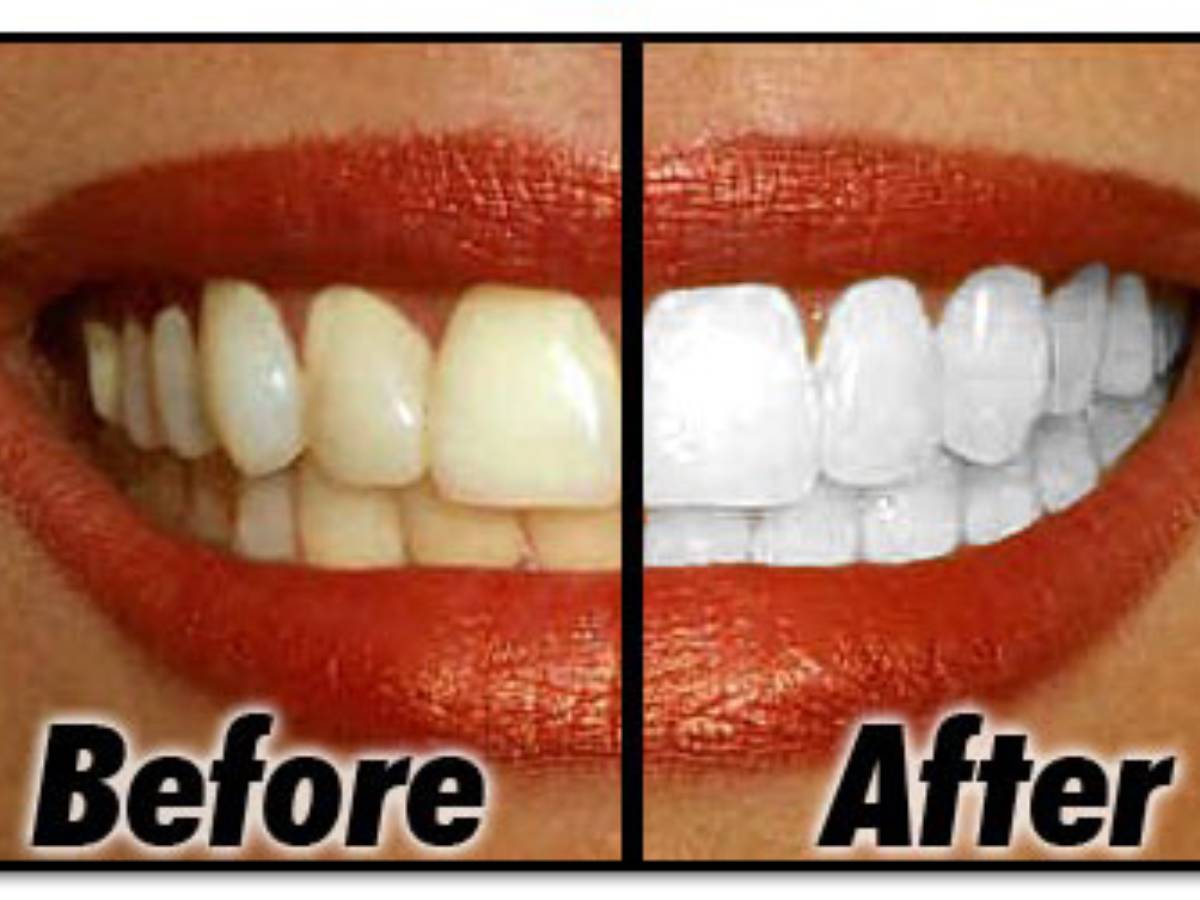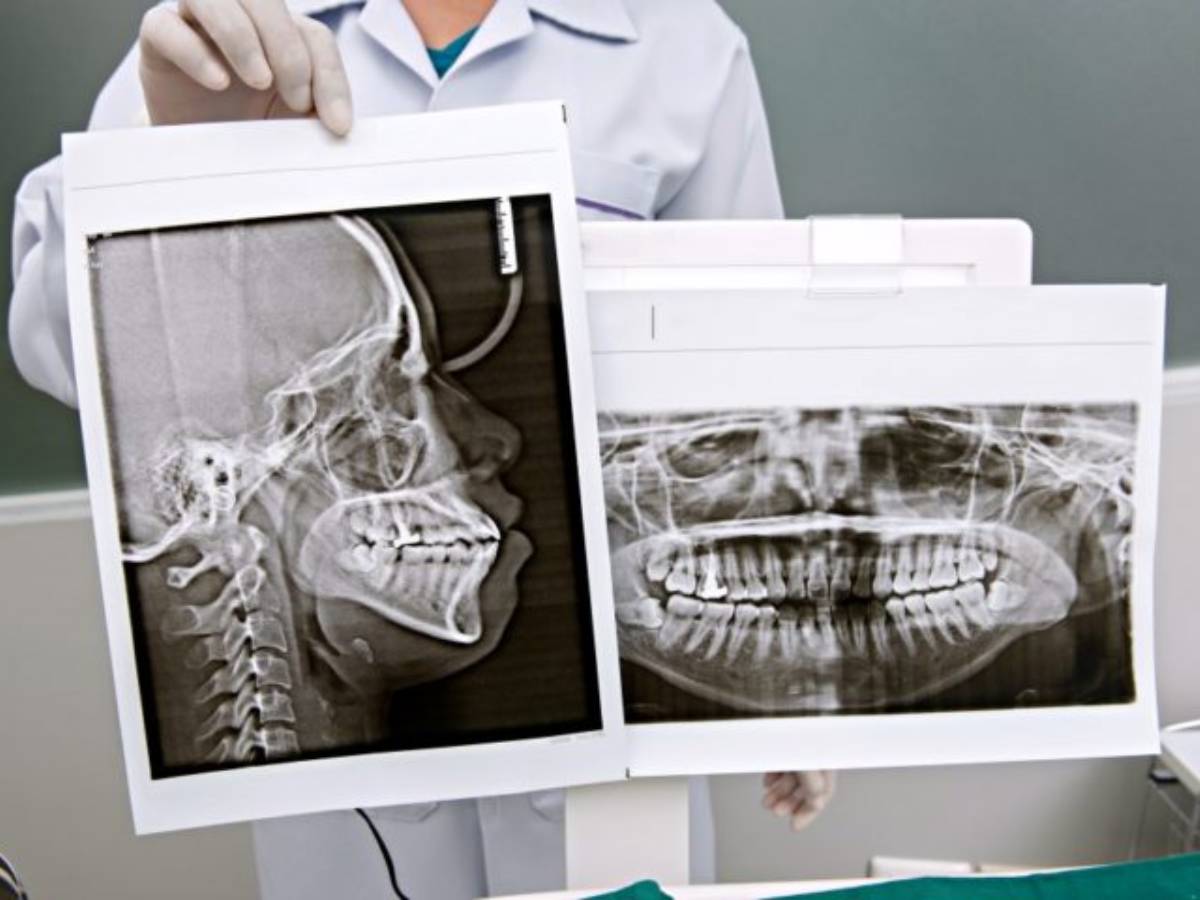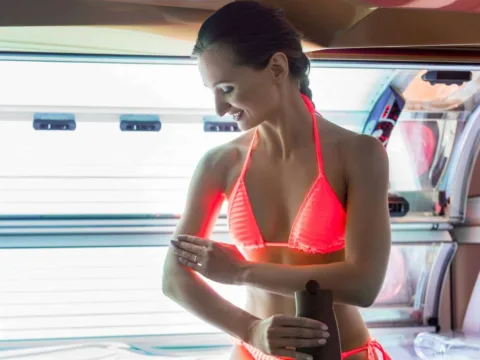
If you’ve been thinking of doing some indoor tanning, then you’re probably wondering whether you should use an indoor tanning lotion to protect your skin and deepen your tan or not — and, if so, the best indoor tanning lotion to use.
I wondered the same thing until I did some serious research.
For years, I tanned indoors without using any lotions at all. As a result, my skin was always a nice brown color — but it was dry, flaky, and didn’t look very healthy after tanning.
I’ve since learned the importance of using an indoor tanning lotion, as well as some tips for keeping my skin as healthy as possible when tanning indoors.
I know, I know… My skin would be much healthier without any exposure to UV rays. But yes, I still visit tanning salons occasionally (usually before going on vacation).
Here’s what I’ve learned about tanning beds & booths… Facts and myths about the safety of indoor tanning.
It’s important to realize that indoor tanning lotions are very different than typical suntan lotions that were formulated for use outdoors.
For one… Did you know that you should never use a regular suntan lotion in a tanning bed? (You should only use indoor tanning lotions in tanning beds.)
In this article, we’ll talk about why, plus some important facts about indoor tanning lotions that you might not realize including:
- How indoor tanning lotions differ from traditional suntan lotions
- UV rays explained: UVA vs. UVB rays
- How indoor tanning lotions work
- Good things about indoor tanning lotions
- Downsides of using indoor tanning lotions
- List of ingredients found in indoor tanning lotions
- How to properly use indoor tanning lotions
- Which lotion I use for indoor tanning
- 3 things you should always do before applying tanning lotion
How Indoor Tanning Lotions Are Different
There are some major differences between indoor and outdoor tanning.
Indoor tanning relies primarily on manufactured UVA rays in a controlled environment — compared to outdoor tanning that consists of both UVA and UVB natural rays in widely varying environments.
Because of these different conditions in outdoor and indoor tanning, different solutions for protection and tanning enhancement should be used.
However, there are also some important differences between indoor and outdoor tanning lotions.
For starters, indoor tanning lotions:
- DON’T have SPF — While most regular suntan lotions contain a sunscreen, indoor tanning lotions typically do not. The belief is with indoor tanning you don’t need as much SPF protection due to the other “helpful” ingredients found in the indoor lotions. Usually, those ingredients are “natural minerals” — but those can only provide very minimal sun protection by acting as a thin barrier on the skin to reflect UV rays. (Also worth nothing… With indoor tanning, your tan time is set to limit your exposure to UV rays — whereas with outdoor tanning, you limit your skin’s exposure to UV rays by selecting the appropriate SPF.)
- DO enhance UV rays, rather than block them — Indoor tanning lotions are specially formulated to enhance the effects of UV rays — typically 95% UVA and 5% UVB (+/-3%). The SPF found in outdoor suntan lotions blocks both UVA and UVB rays — which largely counteracts the benefits of indoor tanning.
- DO work best during short tanning sessions — Regular suntan lotions are designed to protect you during long periods of time spent outside in the sunlight. Indoor tanning lotions are designed for shorter, more intense indoor tanning sessions — resulting in a deeper, quicker tan.
- DON’T damage tanning beds — Regular suntan lotions will damage the acrylic material that tanning beds are made of. (The acrylic hoods are porous and expand when the bulbs heat up.) In addition, using a regular tanning lotion in a tanning bed creates a film on the acrylic that ultimately restricts the tanning process and limits the tan you obtain.
As you can see, if you’re going to use a lotion when tanning indoors, it should be an indoor tanning lotion rather than a typical suntan lotion for use outdoors.
If you prefer to use an indoor tanning lotion with SPF, you probably won’t be able to find one among all the tanning lotions for sale at the tanning salon itself. Due to the effect of SPF on the acrylic parts of tanning beds, most tanning salons frown on the use of tanning lotions with SPF and they only sell indoor lotions without SPF.
Now, you’re probably wondering about the differences between UVA and UVB rays…
UV Rays Explained

According to the Skin Cancer Foundation:
- UVA (ultraviolet-A): Long-wave solar rays of 320-400 nanometers (billionths of a meter). Although less likely than UVB to cause sunburn, UVA penetrates the skin more deeply. UVA is considered the chief culprit behind wrinkling, leathering, and other aspects of “photoaging.” The latest studies show that UVA not only increases UVB ‘s cancer-causing effects, but may directly cause some skin cancers, including melanomas. (Remember it this way: UVA = AGING effects.)
- UVB (ultraviolet-B): Short-wave solar rays of 290-320 nanometers. More potent than UVA in producing sunburn, these rays are considered the main cause of basal and squamous cell carcinomas as well as a significant cause of melanoma. (Remember it this way: UVB = BURNING effects.)
Furthermore, according to the American Academy of Dermatology, a single blistering sunburn nearly doubles your lifetime risk of Melanoma — the most deadly form of skin cancer.
It’s certainly ironic that one of the reasons people tan is to look healthier!
Beyond increasing cancer risk, tanning beds also cause premature aging. Frequent UV exposure can cause brown spots, lax skin, photodamage, fine lines and wrinkles, and a leatherlike texture. Unfortunately, human skin isn’t very forgiving when damaged by UV exposure, and it can only be corrected by cosmetic surgery. People who tan regularly, either in tanning beds or outdoors, can look much older than their peers who don’t tan.
~Very Well Health
Next, let’s turn to the reasons why an indoor tanning lotion is preferred to using nothing at all…
How Indoor Tanning Lotions Work
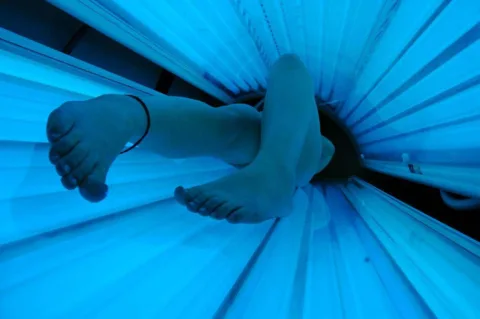
Products formulated specifically for indoor tanning enhance the body’s natural tanning process.
Indoor tanning lotions work by:
- Protecting the moisture levels in your skin
- Allowing your pores to open up
- Magnifying your UV exposure
By controlling your tanning process through magnification, moisturization, and skin conditioning, you will get a deeper and longer-lasting tan.
That’s the real benefit of indoor tanning lotions.
Many of the high-quality lotions also have a refractive prism of natural oils that cause a magnification of the UV light. This helps to intensify your tan.
Indoor tanning lotions that contain vitamins, natural oils, minerals, antioxidants, natural botanical extracts, and aloe vera give your skin the extra moisture needed to achieve a deeper, darker tan that will last longer than dry, unhealthy skin.
According to a 14-day study done by the American Tanning Institute, 100% of those using indoor tanning lotions showed an overall improvement in tan-ability.
Dry skin reflects UV light, so if you’re NOT using an indoor tanning lotion, you can be wasting up to 50% of your tanning session.
~Fit ‘n Tan Salon & Spa
And now for the pros & cons of indoor tanning lotions…
Good Things About Indoor Tanning Lotions
A high-quality indoor tanning lotion that you apply to your skin before entering a tanning bed or tanning booth will…
- Keep your skin moisturized – When tanning, your skin naturally becomes dehydrated from the heat and light. So, when your skin is dry inside of a tanning bed, the lamps will reflect the light off your skin instead of absorbing that light as it would with skin that’s been moisturized with an indoor tanning lotion.
- Get a dark tan faster – The accelerators and intensifiers in indoor tanning lotions are designed to speed up your tan – giving you a deeper, darker tan a lot quicker than someone who didn’t use an indoor lotion.
- Make your tan last longer – By keeping your skin hydrated with an indoor tanning lotion, you will avoid peeling — so your tan will last longer.
- Save time & money – By achieving your desired level of tan quicker and making your tan last longer, you will spend less time in tanning beds and need fewer visits of sunless tanning to build and maintain the same tan. Ultimately, this saves you time and money, because you simply won’t have to tan as often.
- Provide nutrients & vitamins to your skin – Indoor tanning lotions typically contain lots of helpful ingredients (in much smaller quantities than the active ingredients) that nourish your skin, making it softer and healthier.
- Reduce dry skin – Indoor lotions help to reduce the drying effects of the UV rays. Also, since moist skin tans much better than dry skin, using an indoor tanning lotion will not only improve your tan, but it will also improve your skin by making it softer and keeping it hydrated.
- Get fewer wrinkles – Skin that’s been hydrated by an indoor tanning lotion is less likely to form wrinkles as quickly as dry skin. Also, the anti-aging ingredients in these lotions can help to reduce the appearance of wrinkles and premature aging of your skin
- Enhance and even out your tan – By hydrating your skin with indoor tanning lotions, your tan will be more even. Using them on a regular basis can help to enhance the tone of your natural tan and give you that great glow.
- Avoid that “after-tan odor” – Most people experience a smell after tanning that is caused by bacteria on your skin reacting to the UV light and heat from the tanning bed. Many indoor tanning lotions have an anti-bacterial ingredient that will eliminate that odor. Indoor tanning lotions are also fragranced with hundreds of different scents, so you can choose your favorite. (I like coconut… it makes me feel like I’m at the beach.)
- Develop your tan even after you leave the tanning bed – Some indoor tanning lotions have tan enhancing agents. That way, you don’t stop tanning after you leave the tanning bed. Instead, your tan continues to develop for hours later — which is another reason to wait 2 hours before showering.
- Prevent burning – Although most indoor tanning lotions do not contain SPF, and most tanning beds primarily use UVA light, using an indoor tanning lotion can help prevent sunburns by keeping your skin moisturized.
The bottom line…
“Tanning” by definition is a “drying process.” Just think of animal hides and leather!
If you don’t add moisture, vitamins, and minerals back into dry skin, then it will become dry, cracked, and unhealthy.
Adding proper moisture into the skin at the time of tanning (by using indoor tanning lotions) as well as after (by moisturizing at home) is critical to building and maintaining tanned healthy skin.
I don’t claim to know how it works, I can just say that from experience, it does. Indoor tanning lotions make your money go farther because they shorten the time it takes for your skin to start tanning. The downfall of designer indoor tanning lotion is the cost. These can run from $35 to $60 in the tanning salon. Indoor tanning lotions can be used as bargaining chips when negotiation tanning deals, but to save the most money, I prefer to buy mine on Amazon and Ebay. What is offered to me for $50 to $60 in the tanning salon is usually almost 50% less on Amazon and Ebay. Find a seller with high feedback that has ties to the tanning salon industry.
— Hubpages
Downsides Of Using Indoor Tanning Lotions
At first glance, indoor tanning lotions may appear to be relatively safe.
That is until you see the list of ingredients (see full list below).
There are 3 ingredients that stand out as potentially dangerous and/or completely unnecessary:
#1 – DHA (or Dihydroxyacetone) is the main ingredient in most indoor tanning lotions. It’s the same ingredient that’s used in self-tanners (creams, lotions, and gels) that work without light.
Dihydroxyacetone has the chemical name 1,3-Dihydroxy-2-propanone and the chemical formula C3H6O3. It is a three-carbon sugar, a ketotriose, and a primary alpha-hydroxy ketone. DHA is also known as glycerone. DHA interacts with the free amino acids present in sweat and keratin.
In effect, the DHA reacts to the dead skin cells on the surface of your skin which causes your skin to become darker.
More specifically, the DHA in indoor tanning lotions creates a chemical change on your skin — combining with your natural amino acids to produce temporary color on the skin.
DHA concentrations in tanning products range from 3% to 5% (up to 15% in bronzers). A higher percentage of DHA will result in a darker tan, but you will also have a greater chance of streaks.
According to the American Academy of Dermatology, the most effective products available are sunless- or self-tanning lotions that contain Dihydroxyacetone (DHA) as the active ingredient. DHA is a colorless sugar that interacts with the dead cells located in the stratum corneum of the epidermis [first outer layer of skin]. As the sugar interacts with the dead skin cells, a color change occurs. This change usually lasts about 5 to 7 days from the initial application.
— How Stuff Works
#2 – Benzyl Nicotinate and Methyl Nicotinate are the chemical agents used in some indoor tanning lotions to make your skin tingle.
Benzyl Nicotinate is a rubefacient and vasodilator agent with the chemical formula C13H11NO2. It’s used in laboratory research to synthesize organic compounds for pharmaceuticals and agrochemicals. It’s also used as a starting material for producing drugs — like antihistamines and antifungal agents. It is considered safe, with low toxicity — however, it can cause serious eye and skin irritation. Methyl Nicotinate is an organic compound with the chemical formula C7H7NO2. It’s a rubefacient with warming and vasodilatory properties that is used in the pharmaceutical and cosmetic industries. It increases blood flow, improves the appearance of damaged skin, reduces flaking, and restores suppleness to skin.
Tingle tanning lotions increase blood circulation and excite Melanin, which helps you tan faster — because the more oxygen your Melanin is exposed to, the faster you tan.
The “tingle factor” for indoor tanning lotions ranges from 1 to 10, so you can choose a lotion with a high tingle factor or a low one.
Everyone reacts differently to products — including “tingle lotions.” Some won’t even notice a tingle, whereas for others the tingle might be bad enough to be really uncomfortable. That’s why it’s important to test a bit of the indoor tanning lotion on a patch of your skin for 24 hours before putting it all over your body.
Tingle or hot action tanning lotion products can add a little extra fun and relaxation to your tanning session, and can even help you get the ultimate tan. These products contain ingredients (usually benzyl or methyl nicotinate) that cause micro-circulation — which brings blood to the top of the skin, increasing blood flow and oxygenation of the skin cells. This oxygenation helps nutrients reach the skin, which expedites the skin’s natural growth and maintenance processes. The more oxygen your skin gets during tanning, the better your results will be.
— Tanning Bed Life Tips
#3 – Tyrosine is commonly used in indoor tanning lotions as an accelerator — to help you tan faster. However, there’s a lot of confusion and controversy about Tyrosine.
Tyrosine is a chemical compound with the chemical formula C9H11NO3. It’s a nonessential amino acid that the body produces from phenylalanine, another amino acid. Tyrosine is a building block of proteins and is essential for the production of neurotransmitters like dopamine, norepinephrine, and epinephrine, as well as thyroid hormones like thyroxine.
In short, Tyrosine is an amino acid that acts as an accelerator to help your body produce Melanin (the pigment that gives skin its tan color).
Tyrosine can also influence your mood by producing Dopamine, Norepinephrine, and Epinephrine in your body.
When you aren’t using lotion, it takes about 7-10 minutes for your skin to coincide with the UV rays and start producing more melanin. For some of us, that 7-10 minutes is the entire time we are in the tanning bed! When using lotions, the ingredient called Tyrosine cuts down that 10 minutes into 30 seconds for melanin production.
~Beaches Tanning Center
While including Tyrosine in tanning lotion might sound good “in theory,” it probably doesn’t do for your tan what we’ve all been told it does.
Here’s what a Cosmetic Chemist has to say about Tyrosine in tanning lotions:
Taking pills with Tyrosine or rubbing a Tyrosine lotion on your skin doesn’t really help the process. In fact, according to the American Cancer Society, tanning accelerators, such as those formulated with the amino acid Tyrosine or Tyrosine derivatives, are ineffective … evidence suggests they don’t work. FDA considers them unapproved new drugs that have not been proven safe and effective. It makes sense if you think about it – swallowing a chemical like Tyrosine or rubbing it on your skin doesn’t necessarily make it available to the right metabolic pathways.
Here’s a list of the most common ingredients found in indoor tanning lotions:
| Function | Ingredient | Description |
|---|---|---|
| Bronzers / Color Enhancer | Dihydroxyacetone (DHA) | A chemical that reacts with amino acids in the skin’s outer layer to create a temporary “tan” |
| Tanning Accelerator | Tyrosine | An amino acid that helps the body produce Melanin, the pigment that gives skin its tan color |
| Tanning Accelerator | L-Tyrosine | A specific form of Tyrosine believed to be more readily absorbed by the body to produce Melanin more quickly |
| Moisturizer | Aloe Vera | A natural ingredient that soothes and hydrates skin |
| Moisturizer | Vitamin E (DL-Alpha Tocopheryl Acetate is the synthetic version) | An antioxidant that protects skin from free radical damage and also soothes and nourishes the skin |
| Moisturizer | Shea Butter & Cocoa Butter | Natural emollients that lock in moisture and soften skin |
| Moisturizer | Oils (almond, macadamia, coconut, hemp) | Nut oils that deeply hydrate the skin during and after tanning |
| Tingling Agent | Benzyl Nicotinate, Methyl Nicotinate | Lipophilic drugs and vasodilator agents that cause tingling effects on the skin and promote blood flow to stimulate Melanin |
| Silicone | Dimethicone, Dimethicone Copolyol | Improve the spreadability and texture of the lotion |
| Fragrances | Fragrances | Enhance scent of the lotion |
| Preservatives | DMDM Hydantoin | Extend shelf life of the product |
Of all the ingredients in indoor tanning lotions, DHA is the one that raises the most concern.
In a study of the long-term effects of DHA, the results indicate that DHA could cause damage to your DNA and skin cells.
So, if you’re currently using indoor tanning lotions or sunless tanning products which contain DHA, just know that there are similar products available without it.
Here are a few DHA-free indoor tanning lotions:
- Black Coconut Love by Tanning Paradise – a hydrating lotion with Coconut Milk, Coconut Butter, No DHA, and No bronzer
- Somewhere On A Beach by Devoted Creations – a DHA-free bronzer with Buckthorn Berry, Coconut Oil, and Walnut Oil
- Coconut Kisses by Ed Hardy – an indoor tanning lotion that’s cruelty-free, gluten-free, mineral oil-free, and DHA-free
- Black Ice by Ultimate – a cooling hemp DHA-free bronzer
- Sun Proverbs by Elegant Sun – an indoor/outdoor tanning lotion with No bronzer and No DHA
How To Properly Use Indoor Tanning Lotions

Technically, the act of preparing and maintaining your skin for indoor tanning should involve 3 steps.
Unfortunately, most people (including myself) usually only think about step #2 when they think of indoor tanning lotions.
These are the recommended steps:
#1 – Apply a pre-tanning accelerator.
This should be applied before you expose yourself to UV light in a tanning bed. It helps to exfoliate, smooth, and moisturize your skin. The ingredients in these products (vitamins, botanicals and essential oils) nourish the skin and prepare it for the tanning process. Think of it as laying the foundation for building a rich, healthy tan.
#2 – Apply an amplifier.
This moisturizes the skin while you’re tanning and allows UV light to penetrate the skin. Normally, some ultraviolet rays bounce off your body. Amplifiers reduce your skin’s capacity for reflection — so more UV rays can actually get through for a deeper tan.
#3 – Apply an after-tanning extender.
This moisturizes and replenishes your skin after it has been dried during the tanning process. Post-tanners minimize the peeling and flaking, as well as keep your skin moist and healthy. In effect, this makes your tan last longer and fade more evenly.
While all 3 of these steps are helpful, I’ll be honest…
To save time and money, I choose to moisturize like crazy (with my regular moisturizers) before and after the tan instead of buying extra products just for the handful of times I visit an indoor tanning bed.
Here’s an explanation of all the different types of indoor tanning lotions (accelerators, maximizers, bronzers, etc.)
My Favorite Indoor Tanning Lotion
In case you’re wondering, I use Australian Gold intensifier for indoor and outdoor tanning!
It smells great, makes a very subtle difference with the depth of color that I achieve after tanning, and keeps my skin healthy.
An intensifier is a type of accelerator. Its ingredients work with your skin’s Melanin to help bring it closer to the surface — for a more natural tan.
Intensifiers don’t provide immediate results, but they do help you get a darker tan over time and they keep your skin healthy and hydrated. (They’re great for first-time tanners trying to build a base color.)
I prefer an intensifier to a bronzer because I simply want healthier skin and a deeper, more natural tan — rather than additional color on top of my natural tanned color. I also like the extra moisturizers that are found in intensifiers / accelerators.
Plus, it’s mostly the bronzers that have the super high amounts of DHA in them, which can turn your skin orange and leave streaks. (Admittedly, orange streaks occur much less with today’s self-tanners and bronzers than they used to in the past.)
Many believe that the designer indoor tanning lotions are best because they’re manufactured by experts in the tanning industry. The biggest difference in higher priced lotions is that they generally have more of your expensive ingredients in them. For example a high end bottle might have 20% of an ingredient, while a less expensive bottle might only have 2% of the same ingredient.
You definitely want to avoid cheap indoor tanning lotions which contain alcohol or mineral oil. These will dry out your skin, strip your tan, and hinder the tanning process.
For the best skin possible, look for Aloe Vera based indoor tanning lotions.
The Bottom Line…
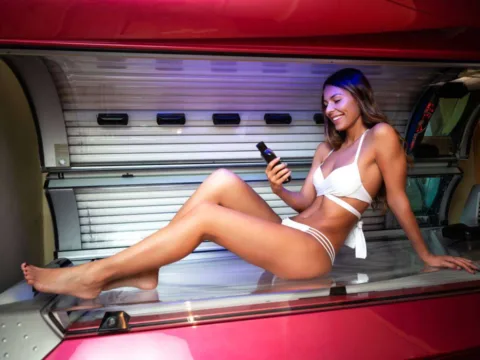
Always wear an indoor tanning lotion inside a tanning bed.
You can lose up to 50% of your tan if you aren’t using quality lotion. The lotion helps your skin absorb the UV rays and will help you get the most out of your tanning session.
~Beaches Tanning Center
Before you put tanning lotion on, you should do these 3 things:
#1 – Exfoliate your skin 24 hours before entering a tanning bed.
Exfoliating removes dead skin cells and gives your skin a smooth base for an even tan. It also helps your skin absorb the tanning lotion properly. Be sure to wait at least 24 hours after exfoliating before you tan — so your skin can settle and recover from any irritation. Exfoliating too close to a tan can weaken your skin and make it more likely to get sunburned. Here’s how I do it:
- First, I use a dry skin body brush (yes, on dry skin — before I get in the shower) to remove flaky dry skin on the surface layer and increase circulation. I use this one.
- Then, I use an exfoliating scrub for the body in the shower to remove all of the remaining dull, dry skin, while hydrating and balancing my skin at the same time. I’ve used this one for decades – ever since I was a teenager!
- Sometimes, I use an exfoliating glove or mitt instead of using just my hands or a washcloth to exfoliate my skin. I like the gloves better than the mitts because you don’t lose your “grip” while exfoliating since you can still use your fingers to maneuver all over your body. Just be sure to choose a heavy-duty exfoliating glove – because the majority of them are way too thin and skimpy, and those tend to fall apart after just one use!
#2 – Moisturize like crazy after exfoliating and before getting your tan.
Use an oil-free moisturizer though. Oil-infused moisturizers can create a barrier over the skin that will prevent tanning. I slather moisturizers all over my face and body immediately after exfoliating, as well as the night before I tan. On the day of my tan, I moisturize like usual in the morning, and then I use Australian Gold intensifier right before I get in the tanning bed. (I return to moisturizing like crazy every morning and every night after I get a tan.)
#3 – Enter the tanning bed with a freshly clean face — to which you apply your indoor tanning lotion.
That is, unless you cover your face with a towel like I usually do — because I don’t really want those harsh UV rays beating down on my face. Everyday makeup, serums, and lotions can prevent the UV rays from reaching your skin – and some can even interact with the UV rays from tanning beds. Indoor tanning lotions are made for this purpose, and most are safe to use on your face.


